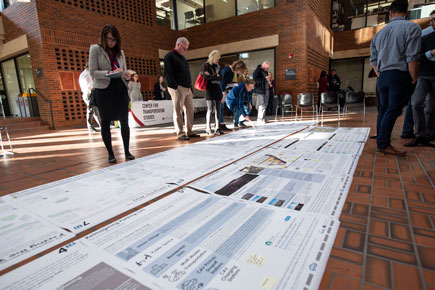Connected and automated vehicles (CAVs) are attracting growing attention from researchers, transportation agencies, and the public at large. This past semester, CAVs were also the focus of a U of M course that centered on how Scott County, Minnesota, could prepare for a future with CAVs.
The course—Public Affairs 5211: Land Use Planning—was offered by the Humphrey School of Public Affairs with support from the U of M’s Resilient Communities Project (RCP). Scott County is one of RCP’s community partners for the 2018–2019 school year.
The course was also supported by CTS as part of a research project led by Professor Thomas Fisher of the Minnesota Design Center and Humphrey School assistant professor Fernando Burga. The project is one of five that received seed funding from CTS last year to explore topics including CAVs, equity, and shared mobility.
Burga, the class instructor, says CAVs are a new field that is ripe for research. “Nobody really knows what’s going to happen, so this offers an opportunity to envision and do new things,” he said.
Working with Scott County gave the students a chance to gain real-life experience with stakeholders. Scott County, in turn, was able to give feedback and gain valuable insights on the changes that might come with CAVs in infrastructure and the ways people live, play, and work.
“This technology is coming,” says Lisa Freese, transportation services director of Scott County. “We know that this is a few years out in the future, but we need to start thinking about how we do these projects.”
On December 7, the 25 students from the class presented their work at a poster session held in the Humphrey School atrium. Each of the six projects was presented as a series of posters that walked viewers through the methodologies, results, and other aspects of the students’ work.
One project—Shared Mobility for All?—focused on the relationship between CAVs and Scott County’s senior citizen population. The team conducted pilot surveys and interviews with a variety of people who would be directly affected, including seniors and social workers. Shanda Hunt, one of the students, says the data visualization skills she developed will be applicable to her position as a public health librarian at the U of M.
Another project explored how CAVs might be used for freight transportation. Students conducted three site visits and did background research to better understand port operations and existing local and national freight issues. Other projects explored CAV relationships with pedestrian safety and looked at how CAVs might connect rural residents to the Twin Cities.
“Every one of these projects offers key takeaways from which Scott County can learn, “ says Mike Greco, RCP director.
RCP, housed within the U’s Center for Urban and Regional Affairs, connects local government agencies with U of M students and faculty to advance community resilience and student learning.




